Chenglin Wu
Advances and Challenges in Foundation Agents: From Brain-Inspired Intelligence to Evolutionary, Collaborative, and Safe Systems
Mar 31, 2025Abstract:The advent of large language models (LLMs) has catalyzed a transformative shift in artificial intelligence, paving the way for advanced intelligent agents capable of sophisticated reasoning, robust perception, and versatile action across diverse domains. As these agents increasingly drive AI research and practical applications, their design, evaluation, and continuous improvement present intricate, multifaceted challenges. This survey provides a comprehensive overview, framing intelligent agents within a modular, brain-inspired architecture that integrates principles from cognitive science, neuroscience, and computational research. We structure our exploration into four interconnected parts. First, we delve into the modular foundation of intelligent agents, systematically mapping their cognitive, perceptual, and operational modules onto analogous human brain functionalities, and elucidating core components such as memory, world modeling, reward processing, and emotion-like systems. Second, we discuss self-enhancement and adaptive evolution mechanisms, exploring how agents autonomously refine their capabilities, adapt to dynamic environments, and achieve continual learning through automated optimization paradigms, including emerging AutoML and LLM-driven optimization strategies. Third, we examine collaborative and evolutionary multi-agent systems, investigating the collective intelligence emerging from agent interactions, cooperation, and societal structures, highlighting parallels to human social dynamics. Finally, we address the critical imperative of building safe, secure, and beneficial AI systems, emphasizing intrinsic and extrinsic security threats, ethical alignment, robustness, and practical mitigation strategies necessary for trustworthy real-world deployment.
MedAgentsBench: Benchmarking Thinking Models and Agent Frameworks for Complex Medical Reasoning
Mar 10, 2025Abstract:Large Language Models (LLMs) have shown impressive performance on existing medical question-answering benchmarks. This high performance makes it increasingly difficult to meaningfully evaluate and differentiate advanced methods. We present MedAgentsBench, a benchmark that focuses on challenging medical questions requiring multi-step clinical reasoning, diagnosis formulation, and treatment planning-scenarios where current models still struggle despite their strong performance on standard tests. Drawing from seven established medical datasets, our benchmark addresses three key limitations in existing evaluations: (1) the prevalence of straightforward questions where even base models achieve high performance, (2) inconsistent sampling and evaluation protocols across studies, and (3) lack of systematic analysis of the interplay between performance, cost, and inference time. Through experiments with various base models and reasoning methods, we demonstrate that the latest thinking models, DeepSeek R1 and OpenAI o3, exhibit exceptional performance in complex medical reasoning tasks. Additionally, advanced search-based agent methods offer promising performance-to-cost ratios compared to traditional approaches. Our analysis reveals substantial performance gaps between model families on complex questions and identifies optimal model selections for different computational constraints. Our benchmark and evaluation framework are publicly available at https://github.com/gersteinlab/medagents-benchmark.
Atom of Thoughts for Markov LLM Test-Time Scaling
Feb 17, 2025Abstract:Large Language Models (LLMs) achieve superior performance through training-time scaling, and test-time scaling further enhances their capabilities by conducting effective reasoning during inference. However, as the scale of reasoning increases, existing test-time scaling methods suffer from accumulated historical information, which not only wastes computational resources but also interferes with effective reasoning. To address this issue, we observe that complex reasoning progress is often achieved by solving a sequence of independent subquestions, each being self-contained and verifiable. These subquestions are essentially atomic questions, relying primarily on their current state rather than accumulated history, similar to the memoryless transitions in a Markov process. Based on this observation, we propose Atom of Thoughts (AoT), where each state transition in the reasoning process consists of decomposing the current question into a dependency-based directed acyclic graph and contracting its subquestions, forming a new atomic question state. This iterative decomposition-contraction process continues until reaching directly solvable atomic questions, naturally realizing Markov transitions between question states. Furthermore, these atomic questions can be seamlessly integrated into existing test-time scaling methods, enabling AoT to serve as a plug-in enhancement for improving reasoning capabilities. Experiments across six benchmarks demonstrate the effectiveness of AoT both as a standalone framework and a plug-in enhancement. Notably, on HotpotQA, when applied to gpt-4o-mini, AoT achieves an 80.6% F1 score, surpassing o3-mini by 3.4% and DeepSeek-R1 by 10.6%. The code will be available at https://github.com/qixucen/atom.
Self-Supervised Prompt Optimization
Feb 07, 2025Abstract:Well-designed prompts are crucial for enhancing Large language models' (LLMs) reasoning capabilities while aligning their outputs with task requirements across diverse domains. However, manually designed prompts require expertise and iterative experimentation. While existing prompt optimization methods aim to automate this process, they rely heavily on external references such as ground truth or by humans, limiting their applicability in real-world scenarios where such data is unavailable or costly to obtain. To address this, we propose Self-Supervised Prompt Optimization (SPO), a cost-efficient framework that discovers effective prompts for both closed and open-ended tasks without requiring external reference. Motivated by the observations that prompt quality manifests directly in LLM outputs and LLMs can effectively assess adherence to task requirements, we derive evaluation and optimization signals purely from output comparisons. Specifically, SPO selects superior prompts through pairwise output comparisons evaluated by an LLM evaluator, followed by an LLM optimizer that aligns outputs with task requirements. Extensive experiments demonstrate that SPO outperforms state-of-the-art prompt optimization methods, achieving comparable or superior results with significantly lower costs (e.g., 1.1% to 5.6% of existing methods) and fewer samples (e.g., three samples). The code is available at https://github.com/geekan/MetaGPT.
FACT: Examining the Effectiveness of Iterative Context Rewriting for Multi-fact Retrieval
Oct 28, 2024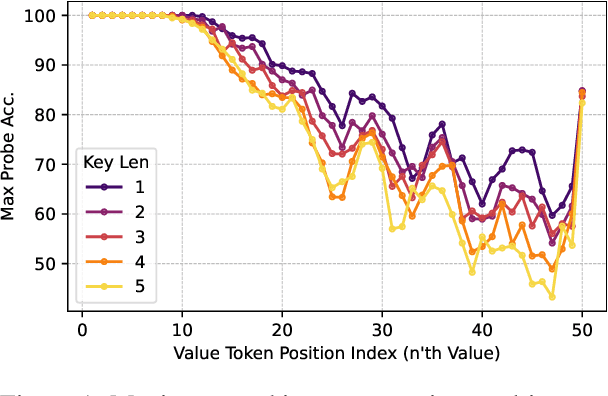

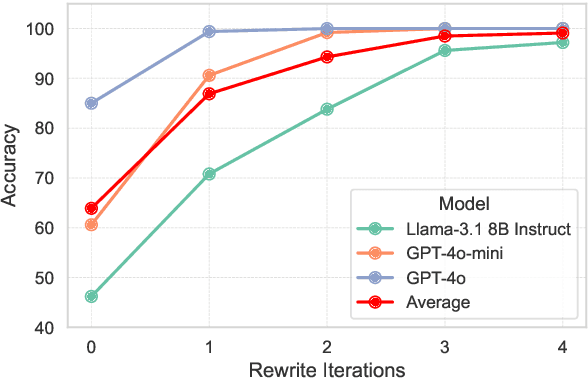

Abstract:Large Language Models (LLMs) are proficient at retrieving single facts from extended contexts, yet they struggle with tasks requiring the simultaneous retrieval of multiple facts, especially during generation. This paper identifies a novel "lost-in-the-middle" phenomenon, where LLMs progressively lose track of critical information throughout the generation process, resulting in incomplete or inaccurate retrieval. To address this challenge, we introduce Find All Crucial Texts (FACT), an iterative retrieval method that refines context through successive rounds of rewriting. This approach enables models to capture essential facts incrementally, which are often overlooked in single-pass retrieval. Experiments demonstrate that FACT substantially enhances multi-fact retrieval performance across various tasks, though improvements are less notable in general-purpose QA scenarios. Our findings shed light on the limitations of LLMs in multi-fact retrieval and underscore the need for more resilient long-context retrieval strategies.
SELA: Tree-Search Enhanced LLM Agents for Automated Machine Learning
Oct 22, 2024



Abstract:Automated Machine Learning (AutoML) approaches encompass traditional methods that optimize fixed pipelines for model selection and ensembling, as well as newer LLM-based frameworks that autonomously build pipelines. While LLM-based agents have shown promise in automating machine learning tasks, they often generate low-diversity and suboptimal code, even after multiple iterations. To overcome these limitations, we introduce Tree-Search Enhanced LLM Agents (SELA), an innovative agent-based system that leverages Monte Carlo Tree Search (MCTS) to optimize the AutoML process. By representing pipeline configurations as trees, our framework enables agents to conduct experiments intelligently and iteratively refine their strategies, facilitating a more effective exploration of the machine learning solution space. This novel approach allows SELA to discover optimal pathways based on experimental feedback, improving the overall quality of the solutions. In an extensive evaluation across 20 machine learning datasets, we compare the performance of traditional and agent-based AutoML methods, demonstrating that SELA achieves a win rate of 65% to 80% against each baseline across all datasets. These results underscore the significant potential of agent-based strategies in AutoML, offering a fresh perspective on tackling complex machine learning challenges.
AFlow: Automating Agentic Workflow Generation
Oct 14, 2024



Abstract:Large language models (LLMs) have demonstrated remarkable potential in solving complex tasks across diverse domains, typically by employing agentic workflows that follow detailed instructions and operational sequences. However, constructing these workflows requires significant human effort, limiting scalability and generalizability. Recent research has sought to automate the generation and optimization of these workflows, but existing methods still rely on initial manual setup and fall short of achieving fully automated and effective workflow generation. To address this challenge, we reformulate workflow optimization as a search problem over code-represented workflows, where LLM-invoking nodes are connected by edges. We introduce AFlow, an automated framework that efficiently explores this space using Monte Carlo Tree Search, iteratively refining workflows through code modification, tree-structured experience, and execution feedback. Empirical evaluations across six benchmark datasets demonstrate AFlow's efficacy, yielding a 5.7% average improvement over state-of-the-art baselines. Furthermore, AFlow enables smaller models to outperform GPT-4o on specific tasks at 4.55% of its inference cost in dollars. The code will be available at https://github.com/geekan/MetaGPT.
Data Interpreter: An LLM Agent For Data Science
Mar 12, 2024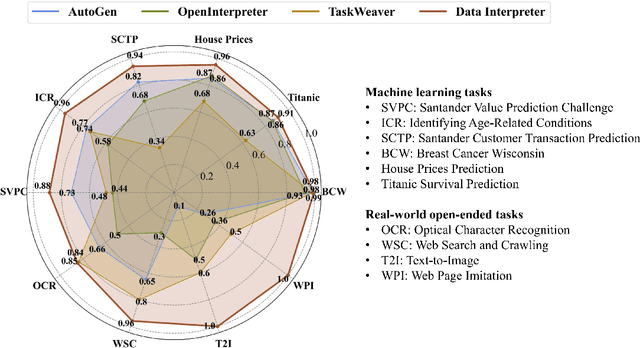

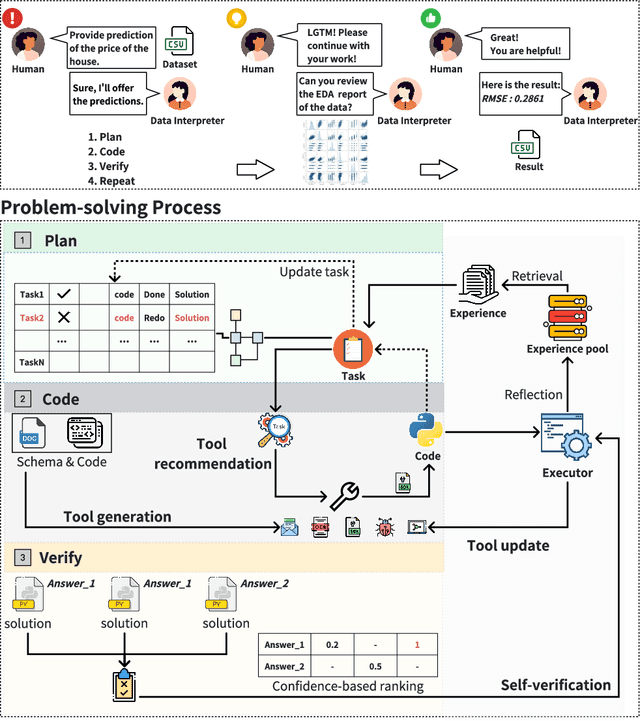

Abstract:Large Language Model (LLM)-based agents have demonstrated remarkable effectiveness. However, their performance can be compromised in data science scenarios that require real-time data adjustment, expertise in optimization due to complex dependencies among various tasks, and the ability to identify logical errors for precise reasoning. In this study, we introduce the Data Interpreter, a solution designed to solve with code that emphasizes three pivotal techniques to augment problem-solving in data science: 1) dynamic planning with hierarchical graph structures for real-time data adaptability;2) tool integration dynamically to enhance code proficiency during execution, enriching the requisite expertise;3) logical inconsistency identification in feedback, and efficiency enhancement through experience recording. We evaluate the Data Interpreter on various data science and real-world tasks. Compared to open-source baselines, it demonstrated superior performance, exhibiting significant improvements in machine learning tasks, increasing from 0.86 to 0.95. Additionally, it showed a 26% increase in the MATH dataset and a remarkable 112% improvement in open-ended tasks. The solution will be released at https://github.com/geekan/MetaGPT.
MetaGPT: Meta Programming for Multi-Agent Collaborative Framework
Aug 17, 2023Abstract:Recently, remarkable progress has been made in automated task-solving through the use of multi-agent driven by large language models (LLMs). However, existing LLM-based multi-agent works primarily focus on solving simple dialogue tasks, and complex tasks are rarely studied, mainly due to the LLM hallucination problem. This type of hallucination becomes cascading when naively chaining multiple intelligent agents, resulting in a failure to effectively address complex problems. Therefore, we introduce MetaGPT, an innovative framework that incorporates efficient human workflows as a meta programming approach into LLM-based multi-agent collaboration. Specifically, MetaGPT encodes Standardized Operating Procedures (SOPs) into prompts to enhance structured coordination. Subsequently, it mandates modular outputs, empowering agents with domain expertise comparable to human professionals, to validate outputs and minimize compounded errors. In this way, MetaGPT leverages the assembly line paradigm to assign diverse roles to various agents, thereby establishing a framework that can effectively and cohesively deconstruct complex multi-agent collaborative problems. Our experiments on collaborative software engineering benchmarks demonstrate that MetaGPT generates more coherent and correct solutions compared to existing chat-based multi-agent systems. This highlights the potential of integrating human domain knowledge into multi-agent systems, thereby creating new opportunities to tackle complex real-world challenges. The GitHub repository of this project is publicly available on:https://github.com/geekan/MetaGPT.
Winning solutions and post-challenge analyses of the ChaLearn AutoDL challenge 2019
Jan 11, 2022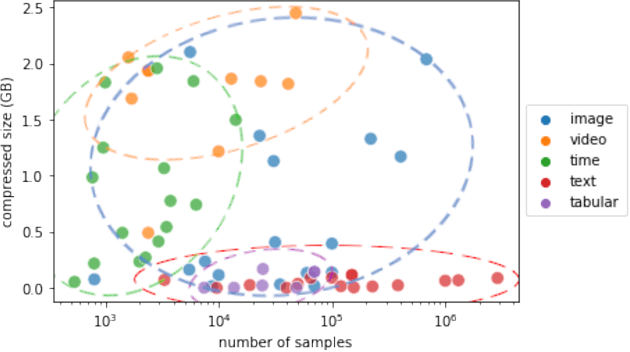
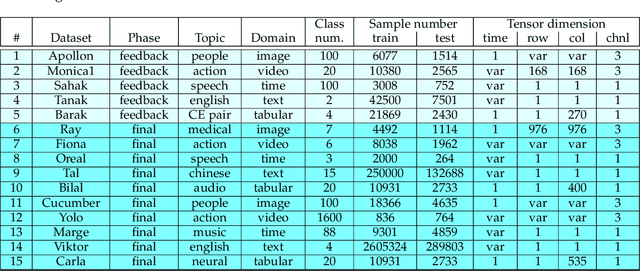
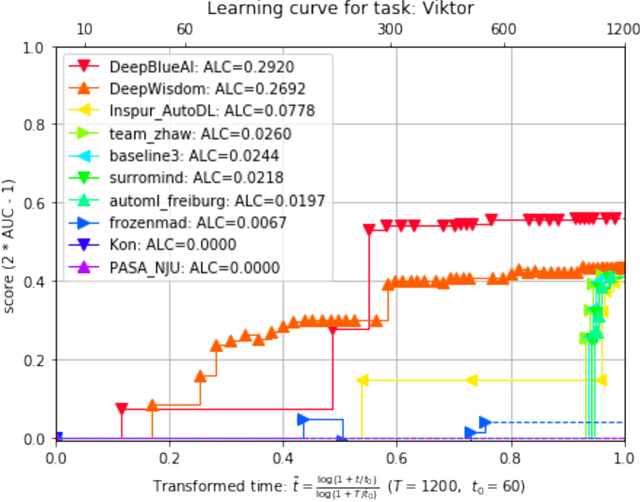
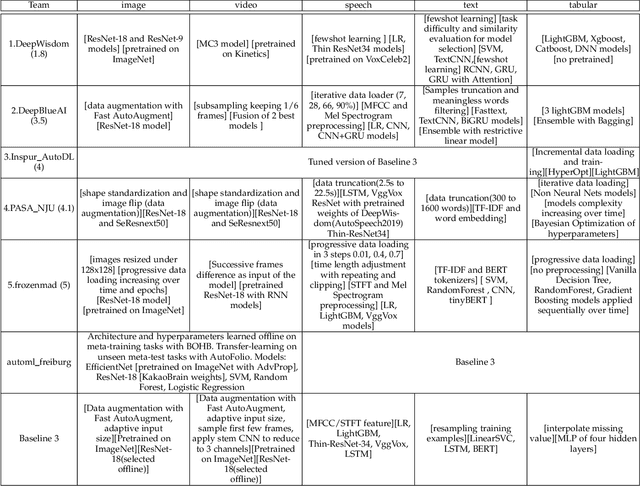
Abstract:This paper reports the results and post-challenge analyses of ChaLearn's AutoDL challenge series, which helped sorting out a profusion of AutoML solutions for Deep Learning (DL) that had been introduced in a variety of settings, but lacked fair comparisons. All input data modalities (time series, images, videos, text, tabular) were formatted as tensors and all tasks were multi-label classification problems. Code submissions were executed on hidden tasks, with limited time and computational resources, pushing solutions that get results quickly. In this setting, DL methods dominated, though popular Neural Architecture Search (NAS) was impractical. Solutions relied on fine-tuned pre-trained networks, with architectures matching data modality. Post-challenge tests did not reveal improvements beyond the imposed time limit. While no component is particularly original or novel, a high level modular organization emerged featuring a "meta-learner", "data ingestor", "model selector", "model/learner", and "evaluator". This modularity enabled ablation studies, which revealed the importance of (off-platform) meta-learning, ensembling, and efficient data management. Experiments on heterogeneous module combinations further confirm the (local) optimality of the winning solutions. Our challenge legacy includes an ever-lasting benchmark (http://autodl.chalearn.org), the open-sourced code of the winners, and a free "AutoDL self-service".
* The first three authors contributed equally; This is only a draft version
 Add to Chrome
Add to Chrome Add to Firefox
Add to Firefox Add to Edge
Add to Edge